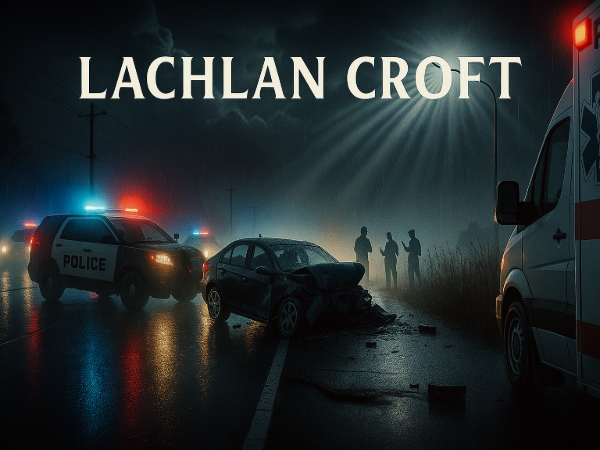Lachlan Croft: The Unverified Story Stirring Online Debate
How an uncorroborated viral claim about a young adult film actor ignited controversy, skepticism, and conversations on digital media credibility

Lachlan Croft is the subject of an unverified but widely circulated online story alleging his involvement in a fatal car accident that reportedly killed two police officers and left another permanently paralyzed. The narrative claims Croft’s reckless actions after inhaling spray paint led to his life imprisonment. While this account has sparked outrage and discussion across social media, no credible mainstream sources have confirmed the details, making it a case study in the dangers of misinformation and the viral nature of sensational online narratives.
Introduction
In the modern digital era, where information moves at the speed of a click, stories can gain massive attention before facts are verified. Lachlan Croft, a name that recently surged in online searches, is a prime example of how an unconfirmed incident can dominate social media discussions and news aggregator feeds. The alleged incident—a fatal accident involving multiple police officers—has provoked intense emotional reactions, speculation, and debates about the truthfulness of online reporting.
This article takes a deep dive into the claims, the source of the narrative, the lack of corroboration, and what this means for public discourse, online journalism, and individual reputations.
Who Is Lachlan Croft?
According to scattered online references, Lachlan Croft is described as a 22-year-old adult film actor. Prior to the viral story, his name was virtually unknown outside certain niche entertainment circles. Publicly available professional information is scarce, and even basic details about his career remain unverified. Unlike public figures with well-documented biographies, Croft’s background lacks consistent and reliable coverage, which makes him particularly vulnerable to the effects of rumor-driven media storms.
The Alleged Incident
The central claim that brought Lachlan Croft into public discussion is dramatic and tragic: a car accident that allegedly killed two police officers, permanently injured a third, and resulted in a life sentence for Croft. The twist in the narrative is the accusation that he was under the influence after huffing spray paint—a detail that adds shock value but also raises questions about sourcing. This account first appeared on a little-known website and quickly spread through social media reposts, forums, and content-scraping blogs.
Tracing the Source
A critical step in evaluating any viral story is tracing its origins. In Croft’s case, the story appears to have originated from a single online article dated August 2024. The outlet that published it is not recognized among mainstream or credible investigative news sources. No law enforcement press releases, court records, or reputable media reports corroborate the details. The absence of multiple independent confirmations is a major red flag for journalists and fact-checkers.
Social Media Amplification
Even without credible backing, the Lachlan Croft story spread rapidly on platforms such as Facebook, Twitter/X, Reddit, and TikTok. Hashtags began trending, and discussions emerged in both English-speaking and international online communities. The viral nature of the story illustrates how sensational claims—particularly those involving crime, celebrities, or shocking behavior—can thrive in the digital ecosystem regardless of authenticity.
Public Reaction
Reactions to the alleged Croft incident have been polarizing. Some online commentators expressed outrage and called for harsh punishment, while others cautioned against believing a story with no reliable evidence. This split highlights a deeper societal challenge: the tension between the human desire for immediate answers and the journalistic need for verification. In many comment threads, users who questioned the story were accused of defending criminal behavior, revealing how quickly debates can become emotionally charged.
The Role of Misinformation
The Lachlan Croft narrative serves as a textbook example of how misinformation can spread. Sensational stories often bypass traditional editorial scrutiny when they are shared directly between users on social media. Once such a story gains momentum, later corrections or clarifications—even if they completely disprove the claim—rarely reach as wide an audience as the original falsehood.
The Problem With Single-Source Reporting
In responsible journalism, multiple independent sources are required before publishing serious allegations. In Croft’s case, the fact that the entire narrative rests on one questionable outlet is a glaring weakness. This approach is the opposite of what reputable investigative reporting would do, especially for a case involving alleged criminal charges and fatalities.
Fact-Checking Challenges
Fact-checking the Lachlan Croft story poses unique difficulties:
No public court documents or police records have been located.
No mainstream reporters have covered the alleged accident.
Croft’s own verified online presence is minimal to nonexistent.
The single published account lacks references to primary sources.
These factors make it nearly impossible for the public to independently verify the claims without official statements.
Impact on Personal Reputation
For a relatively unknown figure like Lachlan Croft, the viral spread of such allegations can be devastating—even if proven false later. The internet rarely forgets; search engine results and social media archives can preserve damaging claims indefinitely. This situation underscores the urgent need for stronger ethical standards in digital publishing.
Legal Implications
If the allegations are fabricated, potential legal remedies could include defamation claims against the original publisher. However, international jurisdictional issues, anonymous authorship, and the cost of litigation often make such actions difficult or impractical. Conversely, if the story is true, public records should eventually confirm the events, but no such confirmation exists to date.
Lessons for Readers
The Lachlan Croft case offers several key lessons for information consumers:
Always check for multiple credible sources.
Be cautious with sensational stories lacking official confirmation.
Recognize the emotional pull of shocking narratives—and question whether facts are being overshadowed by drama.
Understand that trending topics are not always reliable indicators of truth.
The Psychology of Belief
Part of the reason stories like this gain traction lies in human psychology. Shocking incidents trigger strong emotions—anger, disgust, sympathy—which in turn increase the likelihood of sharing content without critical evaluation. Algorithms on social media platforms are designed to promote content that generates engagement, regardless of accuracy, further fueling the spread.
Digital Literacy and Responsibility
Improving digital literacy is crucial in combating misinformation. Understanding how to verify news, identify credible sources, and resist emotional manipulation can help reduce the viral spread of false narratives. The Lachlan Croft case can be used as an educational example in classrooms, media studies programs, and public awareness campaigns.
What Comes Next?
At present, the Lachlan Croft story remains unverified. If official law enforcement records, court documents, or reputable investigative reports emerge, they will either confirm or debunk the claims. Until then, the most responsible approach for both journalists and the public is to treat the story as unconfirmed and approach it with skepticism.
Conclusion
The viral narrative surrounding Lachlan Croft highlights a dangerous reality of our hyperconnected world: misinformation can travel faster and reach more people than the truth. Without corroborating evidence from credible sources, the story should be regarded as speculative. This case emphasizes the importance of patience, critical thinking, and media literacy in an era where the line between fact and fiction is increasingly blurred.



